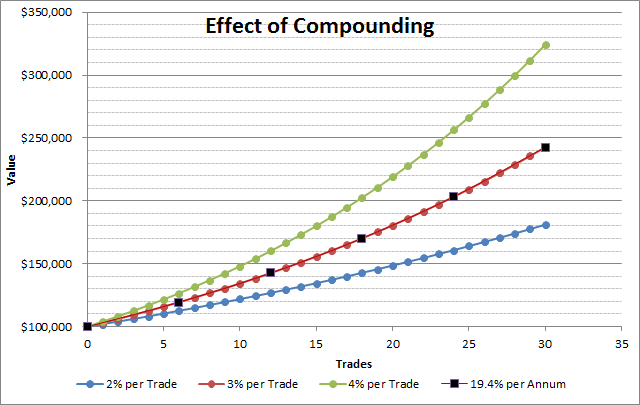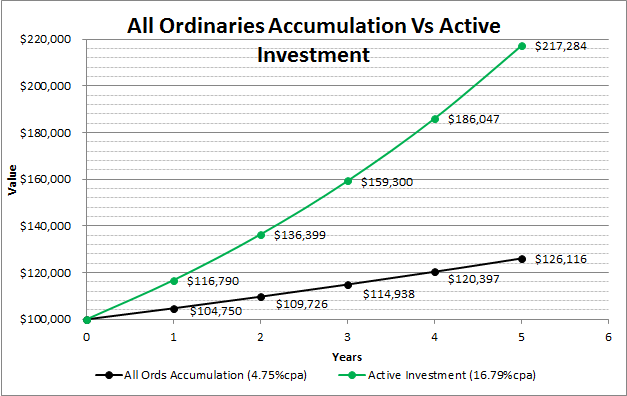Basics of compounding
Following on from last week’s Journal post, I felt it very important to continue our discussion on the positive effects that compounding can have on an active investment portfolio.
A simple way to look at the effectiveness of compounding is to use a mental maths shortcut known as the “Rule of 72”. For those that have not heard of the mathematical principles of the Rule of 72, it allows you to very quickly estimate the compounding effect of any growth rate, from house prices to financial performance. Primarily it allows you to estimate the time a value takes to double. The following examples are useful for calculating financial estimates and understanding the true nature of compound interest.
- With an interest rate of 5% per annum, your money takes 72/5 or 14.4 years to double.
- To double your money in 10 years, you require an interest rate of 7.2% per annum, which is 72/10.
Rule of 72 applies to anything that grows, including interest, inflation and even our population growth. A change in political policy from a growth rate of 3% vs 2% could be a huge problem for planning. Instead of needing to double the country’s services capacity in 36 years, this 1% per annum difference has shorted the time period to 24 years. Twelve years were shaved off the schedule with one percentage point.
How does compounding relate to active investing?
This same rule when applied to portfolio growth in the stock market provides Active Investors with an extremely powerful tool. As it was mentioned in last weeks journal post, “as profits are made from the market they add to the capital base and allow larger position sizes in subsequent trades to be taken. By implementing a strategy that encapsulates the turn over of the same capital in the market, (ie. velocity of money), you are in affect increasing the total amount of capital that is put to use in the market from which to generate profits”. This principle is the very core or essence of Active Investment – compounding profits in the market achieved by the turnover of trading capital.
In the previous SPA3 portfolio example (last weeks Journal post), the portfolio capital was turned over on average every 8.6 weeks or 6 times per year. As the portfolio has made profits, each time a slightly larger amount of capital was re-invested back into the market putting compounding to work.
The amount reinvested back into the market does not have to increase by a large amount. In fact a small percentage increase will have a significant effect over a longer period of time. Let’s have a look at several examples.
Suppose your trades always lasted 8.6 weeks and returned 2% on average. Each subsequent trade reinvested the original capital and the profit back into the market. After 5 years, your portfolio would achieve a total profit of 81%.
Now if you increase the percentage per trade to 3% or 4%, the total profit climbs to 142% and 224% respectively. You can see that the returns are exponential although the change is linear. From 2% to 4% is double but the end result is 2.7 times larger. This phenomenon is also obvious in the shape of the charts.
Don’t forget the buy and hold issue
Don’t forget the buy and hold issue we referred to in last week’s post because it also applies in this case. If you were to only chose a handful of trades per year, the trades would have to average 19.4% just to achieve the same as the 3% compounding curve. The likelihood of an investor achieving this type of buy and hold performance through both good and bad markets is slim to none when taking into consideration that:
-
- Some stocks could very well produce a negative return.
- The performance of the All Ords Accumulation index over the past 5 years has only risen by a mere 4.75% compounded percentage points per annum.
Compare this 4.75% compounded return of the All Ords Accumulation index to that of an active investment compounded strategy that achieves 16.79% over the same period, as has been the case with the SPA3 Public Portfolio from 1/7/2005 to 30/6/2010.
The key here is that you don’t need to make your annual returns from a handful of stocks. I’ll say it again; “Compounding through the reinvestment of profits back into the market is, in my opinion the “Holy Grail to Active Investment”. By executing a strategy that allows you to capture the trend of a trade, so your profit trades can run, and to close trades, so you can capture net profit and protect your capital from stocks that fail to rise, you will be in effect creating the compounding effect.





The rule of 72 has a small deception hidden within. It uses an annualised rate of return (e,g, 7.2%), but to be valid, it requires interest paid and capitalised monthly. Usually difficult to realise in practice.
Best article, lots of intersting things to digest. Very informative